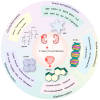Urinary Tract Infections Detection with Molecular Biomarkers
- PMID: 39766247
- PMCID: PMC11673847
- DOI: 10.3390/biom14121540
Urinary Tract Infections Detection with Molecular Biomarkers
Abstract
Urinary tract infection (UTI) is the most prevalent kind of pathogenic bacteria infection, and the midstream urine culture is regarded as the gold standard in UTI diagnosis. Recently, even with modern media and techniques such as polymerase chain reaction (PCR), urinary cultures still create a considerable workload for hospital laboratories. Other UTI-detecting methods, such as flow cytometry and lateral flow immunoassay, suffer from various drawbacks like long time consumption and low sensitivity. Therefore, looking for reliable biomarkers in UTI is urgently needed. In this review, the current definitions of UTI can be basically divided into two main categories: uncomplicated UTI and complicated UTI. In light of anatomical sites, it can be classified as either lower UTI or upper UTI. We take the classification of UTI as a clue and review the reported extensive literature to classify the existing studied markers into the following three categories: Biomarkers used clinically; Promising biomarkers; and Controversial biomarkers. Particularly, the nucleic acid-associated, metabolomic, and lipidomic biomarkers are highlighted. At the end, we discuss the challenges and prospects of biomarkers in UTI, hoping to further inspire the diagnosis of UTI.
Keywords: biomarkers; diagnosis; pathogens; urinary tract infections.
Conflict of interest statement
The authors declare no conflicts of interest.
Figures


Similar articles
-
New markers of urinary tract infection.Clin Chim Acta. 2017 Aug;471:286-291. doi: 10.1016/j.cca.2017.06.003. Epub 2017 Jun 13. Clin Chim Acta. 2017. PMID: 28622967 Review.
-
Effectiveness of Preanalytic Practices on Contamination and Diagnostic Accuracy of Urine Cultures: a Laboratory Medicine Best Practices Systematic Review and Meta-analysis.Clin Microbiol Rev. 2016 Jan;29(1):105-47. doi: 10.1128/CMR.00030-15. Clin Microbiol Rev. 2016. PMID: 26598386 Free PMC article.
-
Point-of-care Testing in Complicated Urinary Tract Infection: Evaluation of the Vivalytic One Urinary Tract Infection Analyser for Detecting Uropathogenic Bacteria and Antimicrobial Resistance in Urine Samples of Urological Patients in a Point-of-care Setting.Eur Urol Focus. 2024 Sep;10(5):734-741. doi: 10.1016/j.euf.2024.09.018. Epub 2024 Oct 17. Eur Urol Focus. 2024. PMID: 39419727
-
Biomarkers for urinary tract infection: present and future perspectives.Pediatr Nephrol. 2024 Oct;39(10):2833-2844. doi: 10.1007/s00467-024-06321-9. Epub 2024 Mar 14. Pediatr Nephrol. 2024. PMID: 38483594 Review.
-
Urine biomarkers individually and as a consensus model show high sensitivity and specificity for detecting UTIs.BMC Infect Dis. 2024 Jan 31;24(1):153. doi: 10.1186/s12879-024-09044-2. BMC Infect Dis. 2024. PMID: 38297221 Free PMC article.
References
-
- Bono M.J., Reygaert W.C. Urinary Tract Infection. StatPearls; Treasure Island, FL, USA: 2021.
-
- Sabih A., Leslie S.W. Complicated Urinary Tract Infections. StatPearls; Treasure Island, FL, USA: 2021. - PubMed
Publication types
MeSH terms
Substances
Grants and funding
LinkOut - more resources
Full Text Sources
Medical

